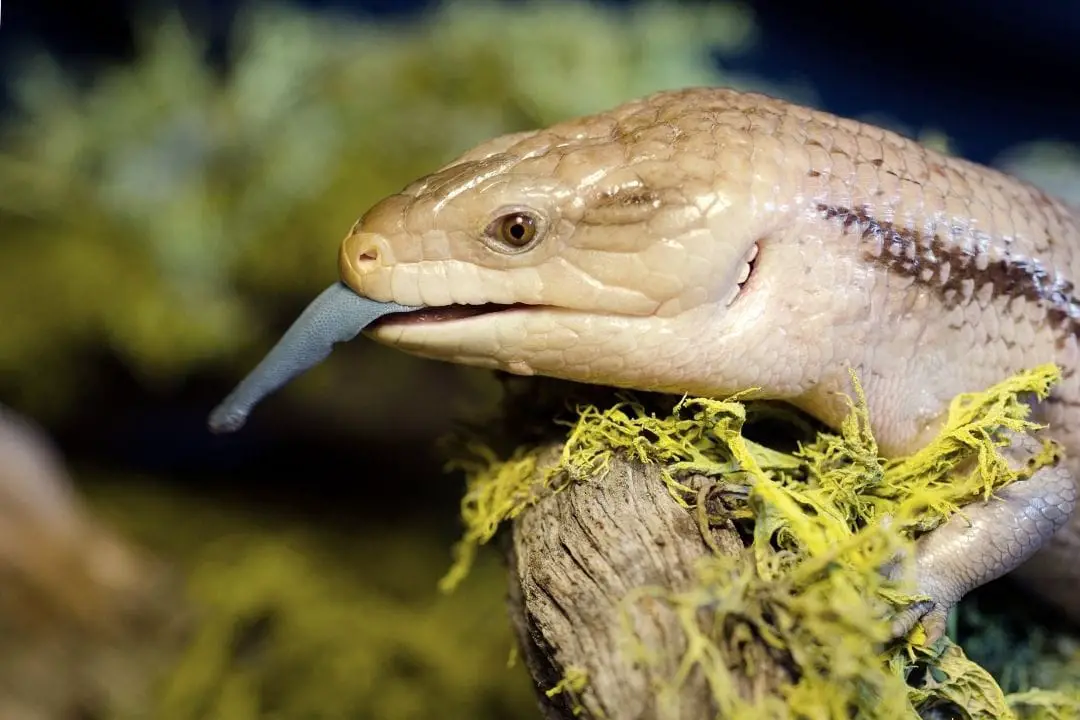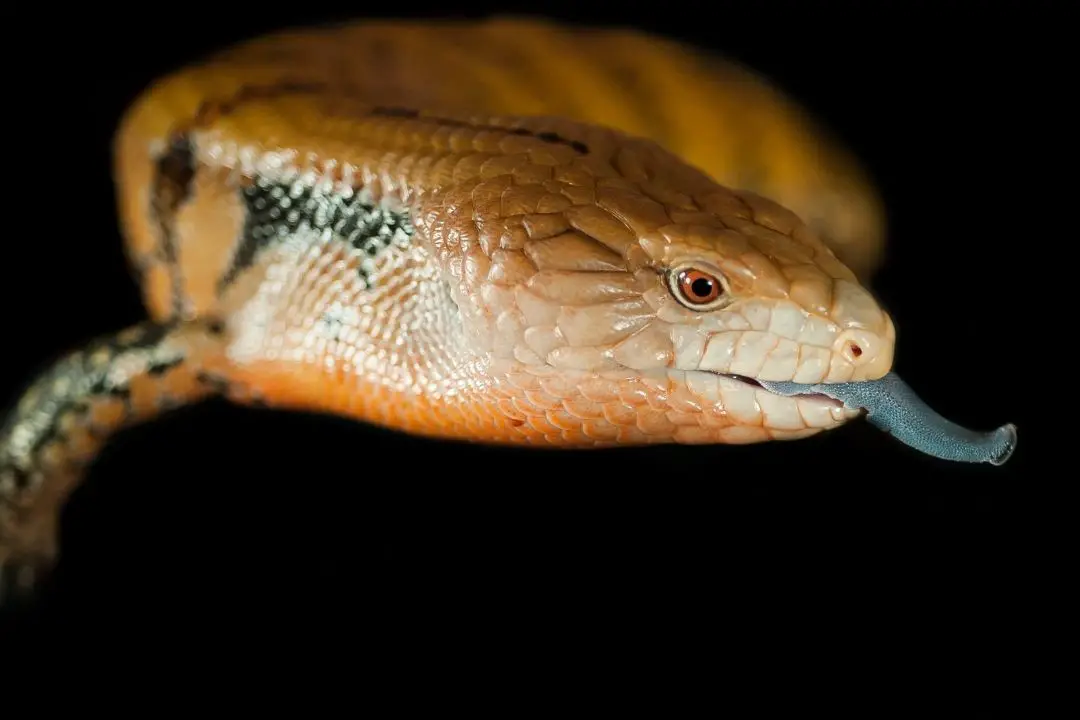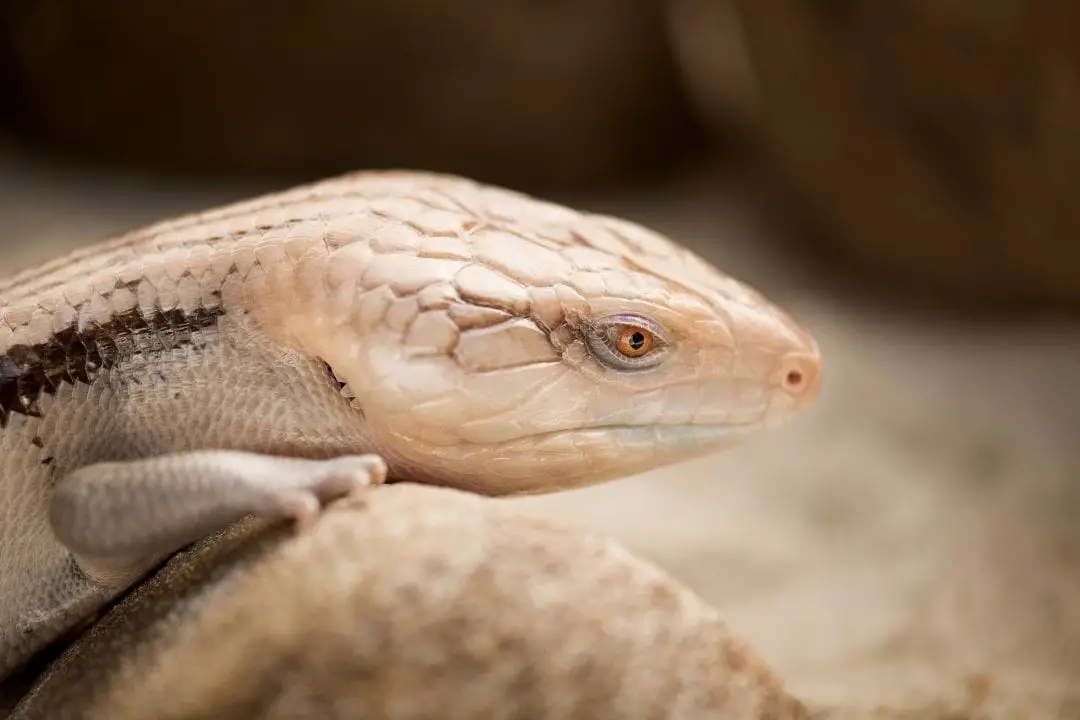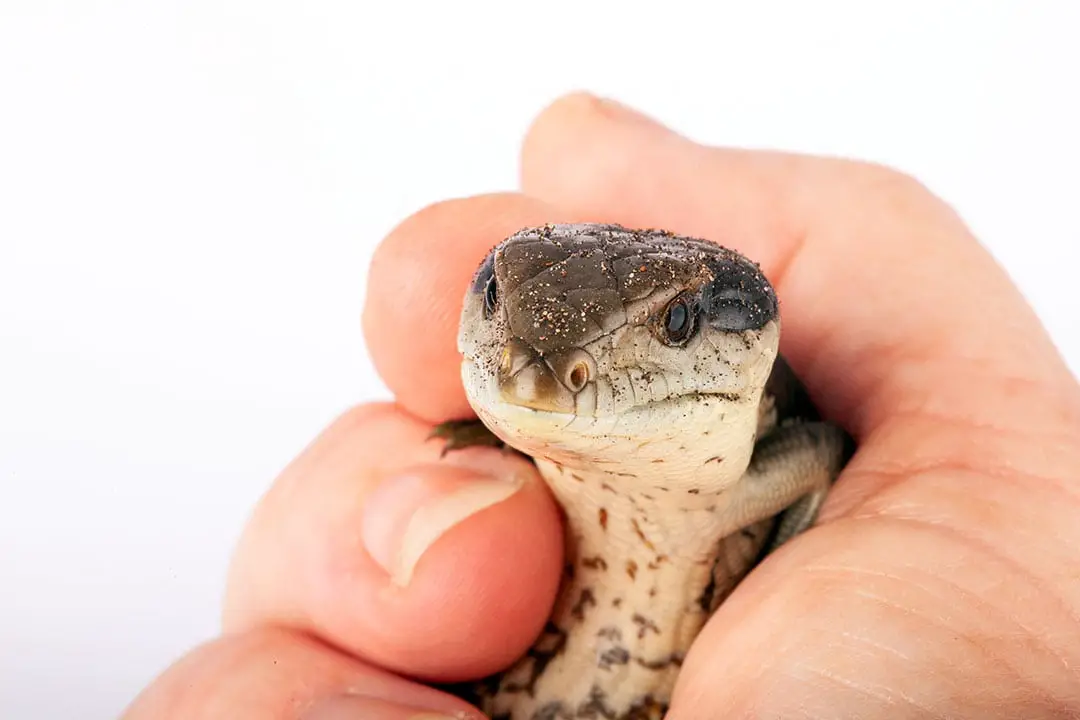Blue-tongued skinks are members of the genus Tiliqua. Multiple species from Australia and Indonesia are commonly kept as pets.
The most common in the United States is the Northern blue-tongued skink (Tiliqua scincoides intermedia).
Other common species are typically imported wild-caught or farm-bred animals from Indonesia. Most species in captivity have similar diet and temperature needs, but the humidity levels will change.
I will list what each species needs in the relevant sections. Be sure you know exactly what species you have.
Housing
The goal of housing your blue-tongued skink is to meet all of its needs. You must create the right temperatures and humidity to help keep your pet healthy. You also need to know how to set up their enclosure so they can use it properly.
Enclosure
Since blue-tongued skinks are terrestrial, you must focus on floor space over vertical space. Juveniles can live in their adult enclosure so long as you add extra clutter and hides to help your pet feel more secure.
Enclosure size for blue tongued skinks
The minimum enclosure size is 4’x2’x2′. You should prioritize an enclosure that is front-opening such as this one. It offers enough space for an adult, but you may still want to upgrade.
You can also opt for a PVC enclosure to help hold humidity. This is great for the Indonesian species since they need more humidity.
Substrate
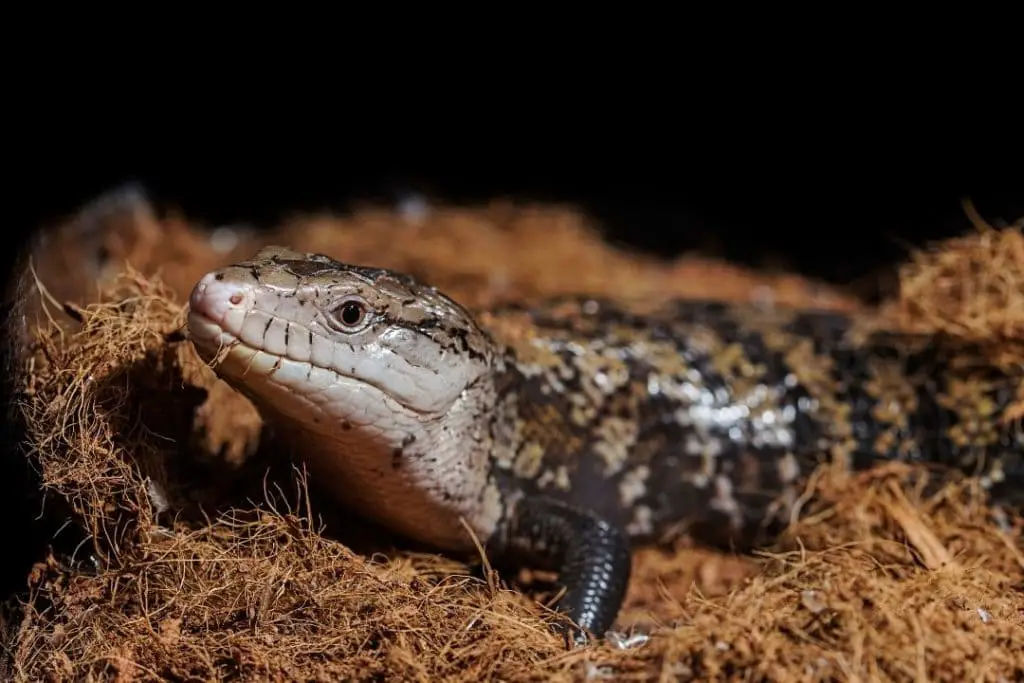
The substrate is important for your skink’s comfort. They burrow, so you will want to offer at least 4 inches of substrate. Since Australian and Indonesian species need different substrates, I will break this down by region.
Indonesia: Most Indonesian skinks need more humidity, so your best substrate option is coconut fiber. Like EcoEarth, you can use any organic brand of coconut fiber.
You can also use Reptichip or a DIY humid substrate mix with 40% organic topsoil, 40% Reptisoil, and 20% play sand. You should not use dry substrates like aspen.
Australia: Most Australian species need low to moderate humidity. Reptichip is a good option as a loose substrate.
You can also DIY your own substrate with 40% play sand and 60% organic topsoil. This mimics their natural habitat closely.
No matter what species you have, a paper towel is a good option for quarantining new animals. Never use any pine or cedar products.
You should also not use pure sand since it can be ingested and may also get stuck under the scales. You can also opt for creating a bioactive enclosure for your pet.
Heating
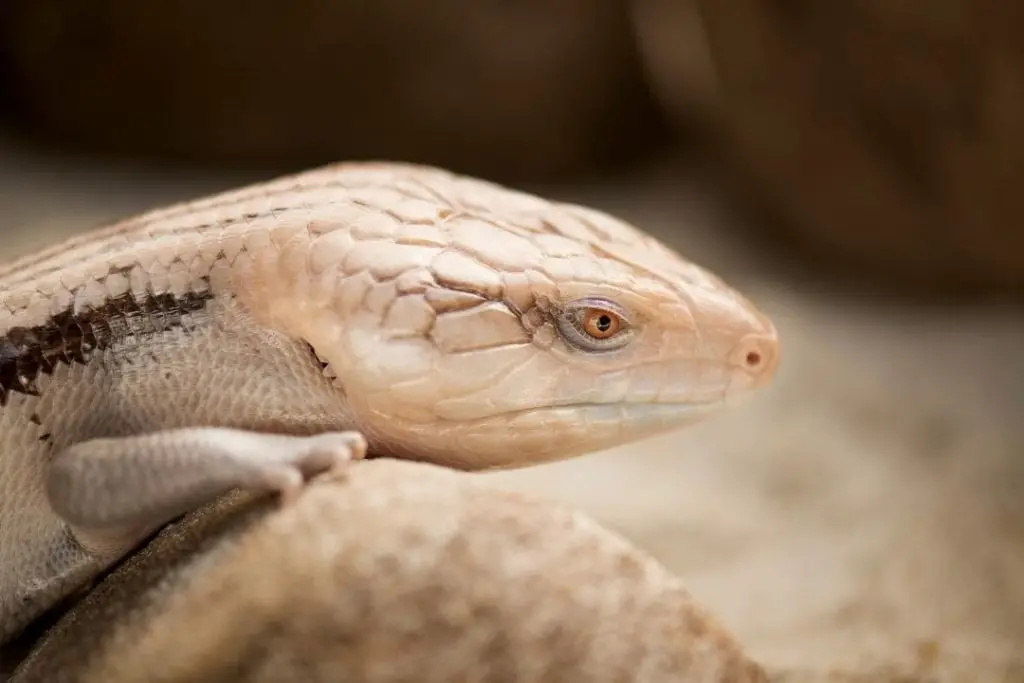
Regarding heating, Australian blue-tongued skinks prefer it hotter than Indonesian species.
The only exception is the banded skink, which prefers slightly cooler temperatures since they are from high elevations in the wild.
Temperature gradient
What is the right temperature for a blue-tongued skink?
For most skinks, the surface of the basking stone should be 100-105 degrees. T. scindoides tend to need higher temps. Aim for 105-115 degrees.
Be sure to use an infrared temperature gun to verify the surface temperature. The air temperatures must be 85-95 degrees over the basking area.
The cool side should be 70-80. Finally, let the temperature drop at night but do not allow it to drop below 65 degrees.
Halogen flood bulbs tend to be a good option for heating. Diurnal lizards like skinks prefer light-emitting heat sources like a basking lamp to regulate their body temperature.
Use a higher wattage if you need more heat or use a dimmer if the temperatures are too high.
The heating should be off at night, but you can use a ceramic heater or a radiant heat panel if your temperatures drop too much.
Since skinks rely on external temperatures instead of generating their own body heat, you must ensure you have the right ranges.
I also highly recommend using a piece of stone as a basking area for your skink. Do not use electronic heat rocks since they will likely injure your skink.
Use a digital thermometer to monitor the temperatures. Place the probes where your skink will spend its time such as the hides.
UVB Lighting
Blue-tongued skinks are diurnal. You should use some form of lighting to help make them more active. You can use any basic lighting including LEDs to simulate daylight.
They do also need UVB to stay healthy. You will want the 10.0 desert-type tubes or the 12% UVB bulbs.
Remember to replace these yearly. UVB is needed for your skink to metabolize vitamin D3. The UV bulb needs to cover at least half the enclosure.
If you have a solarmeter, you want a reading of 3.0-4.0 at the basking spot. Otherwise, you will need to position it closer if you have a mesh top to your enclosure and further if the UV bulb is exposed.
Shelter
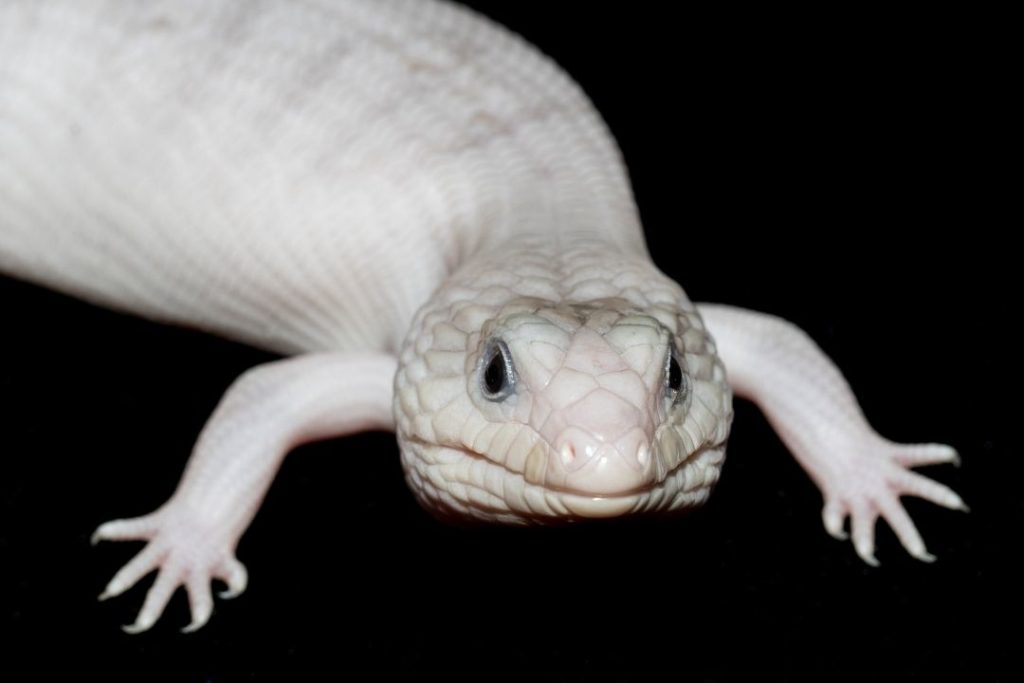
Decorations and toys in the enclosure are important for your skin’s well-being. Enrichment items help keep your skink healthy by encouraging exercise and mental stimulation.
The first factor is making your skink feel safe. Offer one hide on the cool side and an identical hide on the warm side.
There should be damp sphagnum moss in the warm hide to help keep your skink hydrated. While your skink is terrestrial, some climbing options like branches, rocks, and cork tubes are a good idea.
You can either plant your enclosure with live plants or use artificial plants. If you use a glass enclosure, it is important to use a background the covers three sides to help your skink feel more secure.
Water
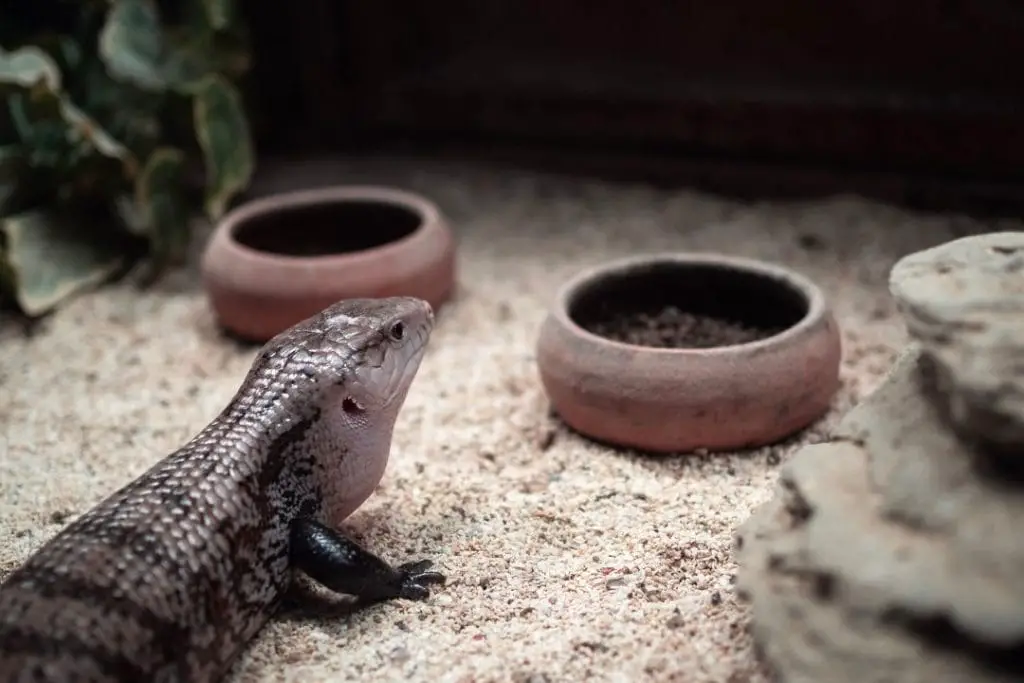
Blue-tongued skinks do need water at all times.
Make sure the water bowl is no more than 3 inches deep, and change it daily. A large, shallow water dish will help maintain humidity as well.
Be sure to sanitize it weekly since skinks frequently use their water dish as a toilet.
Humidity
Humidity is important to keep your skink hydrated and allow for healthy sheds. If the humidity is too low, your skink may have trouble shedding and will be dehydrated.
If it is too high for your species, your skink may have issues with infections.
Since each of the common species needs different humidity levels, I will be listing them separately:
Humidity levels for blue-tongued skinks species:
- Northern blue-tongue (T. scincoides intermedia): 40-60%
- Eastern blue-tongue ( T. s. scincoides: 40-60%
- Tanimbar (T. s. chimeraera): 60-80%
- Blotched (Tiliqua nigrolutea): 40-50%
- Centralian ( Tiliqua multifasciata): 20-40%
- Western (Tiliqua occipitalis): 20-40%
- Shingleback (Tiliqua rugosa: 20-40%
- Classic Indonesian (Tiliqua gigas gigas): 60-80%
- Halmahera (T. g. gigas): 70-100%
- Merauke (T. g. evanescens): 60-80%
- Kei Island (T. g. keyensis): 60-80%
- Irian Jaya (Tiliqua spp.): 60-80%
Use a good digital hygrometer with a probe to monitor the humidity.
You need to mist daily. You may want to invest in a reptile fogger or automatic misting system for high-humidity species like Halmahera.
Use distilled water for automatic systems and clean them with reptile-safe sanitizer regularly.
You can use cypress mulch in your skink’s enclosure and spray it to help maintain humidity.
Diet
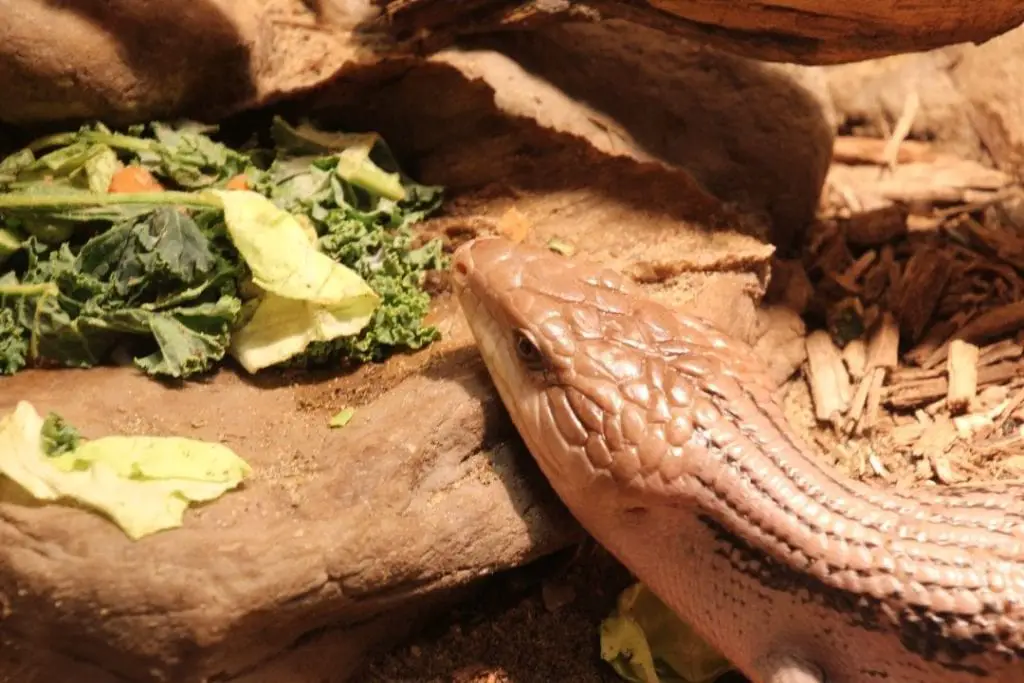
Blue-tongued skinks are omnivores. In the wild, they will eat nearly anything. They have been seen eating fruit, vegetation, insects, and meat.
A captive skink will need a wide diet to stay healthy. Since they have so many options, you have plenty of choices to feed your pet.
Diet Options
You have a wide variety of options available for feeding your blue-tongued skink. There are prepared skinks food diets available:
Generally, you want a mix of protein, vegetables, and small amounts of fruit in your skink’s diet. For insects, they can eat a wide variety of feeders including live or canned snails, Dubia and discoid roaches, grasshoppers, earthworms, hornworms, and more.
Meat options include raw or cooked eggs, ground lean meats like turkey or rabbit or lean ground beef, and organ meats. Skinks should also have vegetables in their diets.
You can feed squash, carrots and their greens, mustard greens, dandelions, hibiscus flowers, bell pepper and more. Fruit should make up no more than 10 of the total diet, but skinks love fruit.
Pitted stone fruits, bananas, strawberries, raspberries, and blueberries all will be safe for your skink.
You can also use wet dog or cat food to feed your skink. Young skinks typically eat cat food since it has more protein while adults will eat dog food with added vegetables.
Please note that shingle backs need far more vegetables. They should be fed around 70-80 vegetables with added insects since that is their diet in the wild.
When selecting a dog or cat food for your skink, be sure that you avoid anything with fish or artificial dyes or flavors. Grain is fine so long as the food isn’t primarily carbohydrates.
Cat food works well for skinks under a year, and then you should feed older skinks dog food mixed with vegetables or the Repashy powders to help add more vegetation.
How often to feed a blue-tongued skink
- A baby under 3 months old needs to eat every day.
- Juveniles that are between 3-8 months old should eat about three times a week.
- Adults should be fed once or twice a week, depending on the animal’s current body condition. Shinglebacks need to be fed twice a week.
You should feed about 1-2 tablespoons per feeding. This is about the size of the skink’s head.
Supplements, Treats, and Nutrient Needs
Your skink should not be given a multivitamin if you are feeding a prepared diet. Most prepared options are already fortified. If you are making up your own diet from safe foods, adding a multivitamin can help.
You should also give your skink calcium once a week for adults and twice a week for juveniles. If you are offering UV, do not use one with D3.
All insects should be dusted with calcium and gut loaded if you bought them more than 24 hours before you feed them to your skink.
One thing to note with the diet is the protein needs. Skinks under a year need about 70-80% of their diet as protein.
Adults need about 40-50%. Shinglebacks need 20-30% protein as adults.
If your skink doesn’t get enough protein, the scales can deform and start to pyramid. Too much protein for an adult will make them fat and risk causing a kidney shutdown. Always monitor your skink’s protein needs closely.
Treats are a great way to offer enrichment. Many treats can be used for training or for food puzzles. Superworms are a great insect treat, and so are fuzzy or pinky mice for larger skinks. You can also feed whole fish that is in bite-sized chunks.
Unsafe Foods
There are a few unsafe foods for skinks. First, never offer wild-caught bugs or other prey items. Lightning bugs and scorpions are very unsafe for skinks.
You should also never feed citrus, rhubarb, avocado, azalea flowers and leaves, daffodils, anything in the hemp or marijuana family, lily of the valley, buttercup, eggplant, tulips, and any pit or seed. While blue-tongued skinks can eat plenty of foods, you must be careful.
You will also want to feed lower-fat foods or watch protein intake if you notice your skink is becoming obese.
Shedding
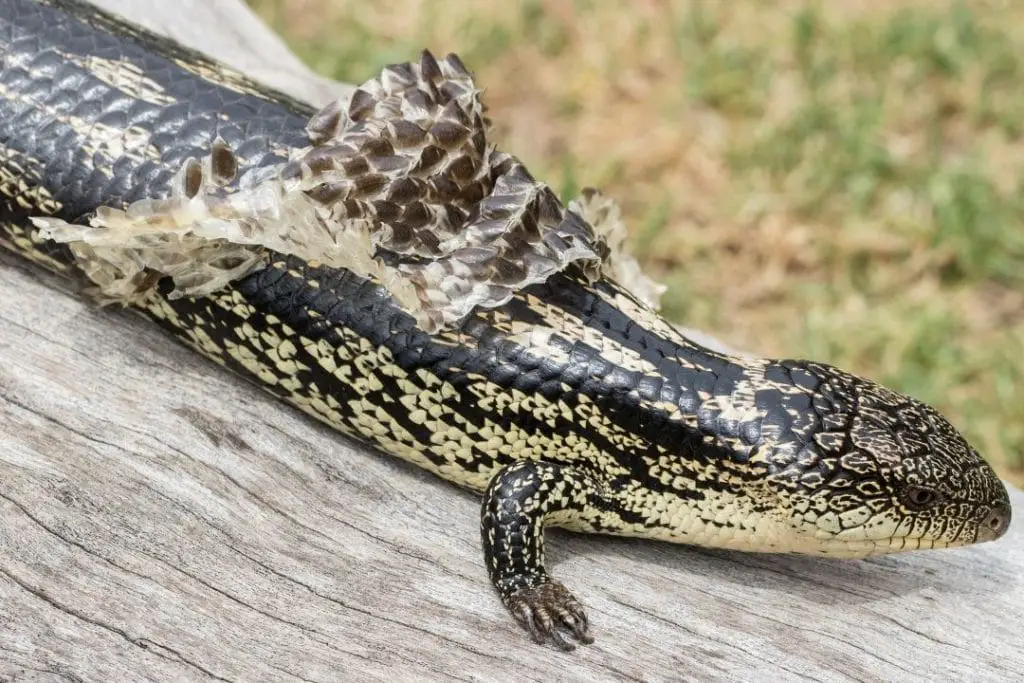
Skinks need to shed their skin to grow. Your skink will need a proper humidity level to shed. You can add a humid hide filled with sphagnum moss when your skink is getting ready to shed.
You will notice your skink becoming dull in color and it will likely be less active.
Raising the humidity to a higher level for your species is also a good tip. Once your skink has shed, check it for stuck shed.
The most likely areas to have stuck shed are the head, tail, and toes. Be sure to check if your skink has stuck shed after each shed.
Many patches will come off with he next shed so long as you fix the humidity. If it is on the toes or might be too tight on the toes or tail, you will need to help your skink shed.
A soak in lukewarm water can help or place the skink in a lidded tub with warm, damp paper towels. Do not ever force a shed off or you may remove the healthy skin.
Handling and Enrichment
Blue-tongued skinks need regular mental stimulation.
They can easily become bored in a barren enclosure. You will also need to encourage exercise to keep your pet healthy and happy.
The first step will be taming your skink. Captive-bred animals from a long line of captive animals will be easier to tame than a wild-caught or first-generation captive.
They like to move around with their short legs and will happily go explore your house or apartment, just make sure they can’t get lost, and be careful with cats or dogs.
Be patient and most skinks will tame down over time. However, some wild-caught animals will always be stressed out by captivity.
In the United States, Australian species like the Northern blue-tongued skink will be easier to tame than Indonesian blue-tongued skinks.
The first step to taming your skink will be as simple as getting them used to your presence. Sitting in the same room and talking to the skink while it is in its enclosure will help get it used to you.
Once the skink is calm when you are in the room, you can move on to getting the skink used to you without the enclosure. Pick a room with no hiding places or dangers and place your skink in it.
You will sit and keep yourself busy with another quiet activity like reading. This will help your skink learn that you don’t want to eat it.
Most skinks will initially try to hide and avoid you. Be patient and let the skink come to you.
Very curious skinks may come up to examine you the first time you do this, while others may take a few attempts.
Never make loud noises or sudden movements around your skink. While you know you don’t want to hurt your skink, it will think you are a predator until you take the time to earn its trust.
Once your skink will allow you to hold it, always support the whole body and tail along your forearm. Skinks are surprisingly hefty and they cannot handle being dropped.
If you are afraid you will drop your pet, it is best to place them down somewhere safe. Dropping your pet will lose a great deal of progress and trust.
You can pet your skink, but avoid the top of the head. They have a small, light-sensitive spot on the top of the head called the parietal eye.
You can pet gently along the body or under the chin. The belly should also be avoided. Most blue-tongues will only tolerate handling for a few minutes.
If you work with your skink, you can extend this time.
Once your skink is calm and still, you can increase the handling sessions by a single minute. Always start with times under five minutes.
Blue tongued skink behavior
Skinks do have body language that you need to pay attention to. An annoyed skink will huff or snort at you in short bursts. Longer huffs, hisses, and tilting the body or puffing up are aggressive behaviors.
Tail flicking or wagging can look friendly, but it means your skink is angry or getting irritated.
Finally, a defensive skink will display its mouth and tongue. This is their defense mechanism.
This means you need to back off immediately. You should only ignore this behavior if your pet needs emergency veterinary attention or is in danger. Always allow a defensive skink time to relax or you may stress out your pet.
When it comes to enrichment, you can train your skink or allow it to do puzzles.
This can be as simple as scattering a treat food like blueberries under crumpled paper since this allows your skink to forage.
Some skinks will also enjoy more complex puzzles. Food puzzles meant for dogs, or cats can be fun. What puzzles work best for your skink will depend on what it likes.
Target training tends to work, and skinks have good enough hearing that you may be able to teach your pet to come to you when called.
Find your skink’s favorite treats and save them for training or puzzle time. This can help ensure your skink will get mental stimulation.
You should also offer some climbing opportunities and exercise opportunites. If you have a safe room, a brief time out to explore novel areas can help your skink get exercise.
Your skink may also enjoy spending time with you, but this will depend on the animal and its personality.
Frequently Asked Questions
Are Blue-Tongued Skinks Hard to Take Care of?
Most species are easy to care for. The Australian species tend to be good beginner pets. The Indonesian species need a combination of high heat and high humidity, which can be hard for a beginner to maintain.
Make sure to consider the total cost of setup and ongoing feeding costs for tiliqua species.
As they are similar looking, make sure you are looking at a blue tongued skink and not a pink tongued skink, as these will only eat snails and slugs, and are more difficult to care for.
Do Blue-Tongued Skinks Like to be Held?
Most blue-tongued skinks enjoy interacting and many enjoy being held. You do need to gain your skink’s trust before it enjoys being held.
Do Blue-Tongued Skinks Need a Heat Lamp?
Blue-tongued skinks need high heat. A halogen heat bulb or a ceramic heat emitter tends to be the best option. Most homes are too cold for a skink to stay healthy.
What Size Tank do You Need for a Blue-Tongued Skink?
An adult skink needs a minimum of 8 square feet of floor space. This means that the minimum size is 4’x2’2′. Since skinks are active lizards, bigger tends to be better.
Are Blue-Tongued Skinks Friendly?
Most captive-bred blue-tongued skinks can be easily tamed down. They will enjoy watching and interacting with you on average.
Read my more in-depth article about blue tongued skinks friendliness and behavior here.
Are Blue-Tongued Skinks Poisonous?
Blue-tongued skinks are not poisonous or venomous.
Are Blue-Tongued Skinks Good for Beginners?
On average, blue-tongued skinks make a good first lizard for reptile keepers, so long as you get a Northern or Eastern blue-tongued skink. These ground dwellers are larger than other beginner reptiles but are less fragile.
See my article about blue tongue skinks for a beginner lizard owner.
Are Blue-Tongued Skinks Expensive?
Blue-tongued skinks can be expensive depending on the species. Wild-caught animals from Indonesia are cheaper but more likely to need more veterinary care and tend to be skittish. Most animals will be over $300 for a captive-bred skink.
How long does a blue-tongued skink live?
The Blue-tongued skink’s average lifespan is fifteen to twenty years depending on diet and care.
Conclusion
I hope this helps you keep your new pet skink happy and healthy for many years. These wonderful animals with their triangular heads and stubby legs can live for over 20 years, so you can expect to enjoy your pet for years to come.
Please ask in the comments below if you have any questions that weren’t addressed in the care sheet.
